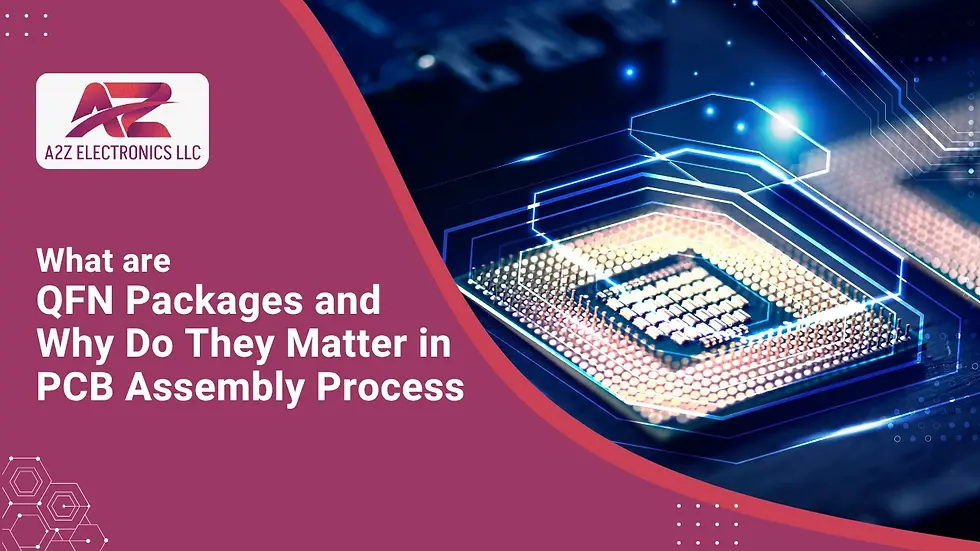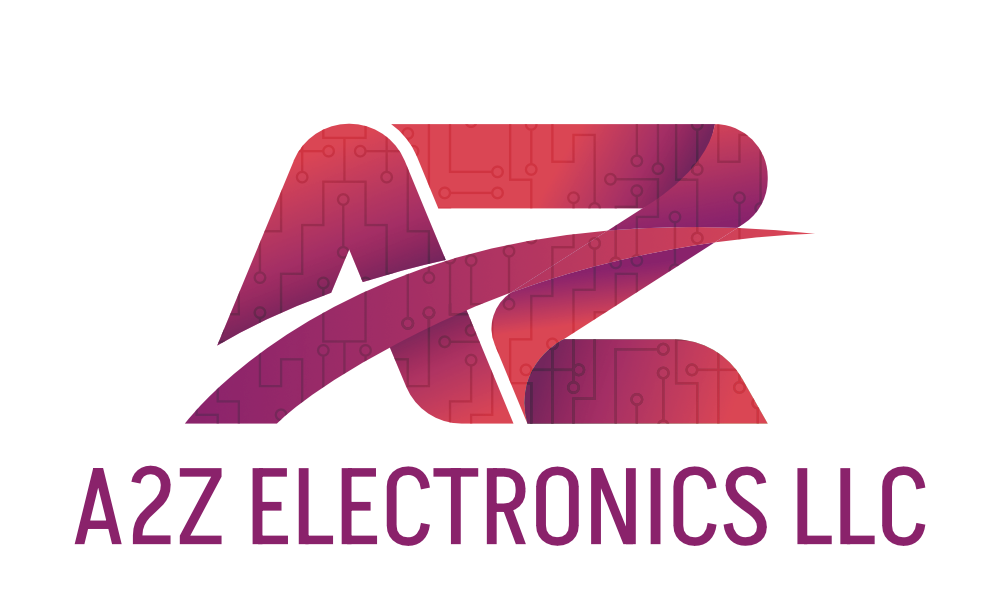What are QFN Packages and Why Do They Matter in the PCB Assembly Process?
- Harshit Shah

- Jun 30
- 7 min read
Updated: Aug 21
As electronic products become more compact, powerful, and application-specific, packaging technologies must evolve to keep pace with design and manufacturing demands. Among the most widely adopted solutions in modern PCB assembly services is the QFN package (Quad Flat No-Lead).

Table of Contents
What is a QFN Package?
A QFN package is a leadless surface-mount IC package that features terminals on the component's underside. It has a flat, square, or rectangular body with an exposed thermal pad at the center, offering superior heat dissipation and electrical grounding. The compact design and low inductance of QFN components make them highly suitable for high-frequency applications and densely populated boards.
In modern PCB assembly , QFN packaging plays a critical role in delivering thermal efficiency, mechanical stability, and compact form factors. This makes it a go-to choice for industries such as automotive electronics, telecommunications, medical equipment, consumer electronics, and industrial automation.
This guide explores QFN packages, how they’re manufactured, and why they play a critical role in today’s electronics manufacturing process.
You may also read: PCB Manufacturing Process: A Step- By-Step Guide in 2025
Types of QFN Packages
QFN packages are available in several variations, each engineered to address specific challenges in board design, thermal regulation, and inspection efficiency. Selecting the right quad flat no-lead package depends on the application environment, performance requirements, and assembly method used by the PCB assembly company. Below are the most common types:
1. Standard QFN (Single Row)
This is the most widely used QFN package. It features leadless contacts on the sides and a large exposed pad on the underside for efficient heat dissipation and ground connection.
Best for: Compact designs where board space is limited but thermal performance is a priority
Common use cases: Consumer electronics, power management ICs, and IoT modules
2. Dual Row QFN
This version offers two rows of perimeter contacts, allowing for a higher number of I/Os within the same footprint compared to standard QFNs.
Best for: High-pin-count applications that require additional signal routing
Common use cases: Advanced MCUs, communication ICs, and industrial controllers
3. Wettable Flank QFN
Designed with beveled edge plating to support reliable solder joint formation and better visibility during Automated Optical Inspection (AOI). This makes it highly suitable for high-reliability production environments.
Best for: Automotive and aerospace applications where inspection standards are stringent
Benefit: Enables compliance with IPC standards and reduces false AOI rejects
4. Air Cavity QFN
Instead of being molded solid, this version includes a small air gap around the die. It is optimized for high-frequency and RF applications that require minimal parasitic capacitance and signal loss.
Best for: High-speed RF circuits, analog front ends, and communication modules
Common use cases: Telecom infrastructure, radar systems, and high-frequency amplifiers
Why Is the QFN Package Used in PCB Assembly?

QFN components have become a favorite in PCB assembly due to their superior performance and efficient use of board space. Here's why they're commonly chosen:
Compact Size: Their low-profile structure is ideal for space-constrained devices like smartphones or IoT modules.
Improved Thermal Dissipation: The exposed center pad helps transfer heat directly to the PCB, minimizing thermal stress on components.
High Signal Integrity: Short interconnects lower inductance and resistance, critical for high-speed signal transmission.
Cost-Effective Manufacturing: QFNs are more economical than BGA packages while delivering comparable performance.
These benefits make QFN packages an optimal choice for modern PCB assembly companies looking to deliver high-reliability electronics at scale.
How Are QFN Packages Made?
The manufacturing process for QFN packages is engineered for precision, scalability, and compatibility with high-speed PCB assembly services. These packages are developed using advanced semiconductor packaging techniques that ensure thermal efficiency, electrical performance, and cost-effective production.
Here is a step-by-step breakdown of how quad flat no-lead packages are made:
1. Die Attachment
The process begins with placing the silicon die directly onto the exposed metal pad of the leadframe, typically made of copper for excellent thermal conductivity. High-precision adhesive or solder is used to secure the die in place. This pad also acts as the heat dissipation interface once integrated into the PCB assembly process.
Objective: Create a strong mechanical and thermal foundation for the die
2. Wire Bonding
Ultra-fine gold or aluminum wires are then bonded from the chip's bonding pads to the surrounding metal leads on the leadframe. This creates the electrical pathways that connect the IC to the outer world.
Technology used: Thermosonic bonding for high-reliability interconnects
Benefit: Enables consistent signal transfer from die to board-level contacts
3. Encapsulation (Molding)
The internal assembly is encapsulated using an epoxy resin or molding compound. This step protects the delicate die and wire bonds from environmental stress, moisture, and mechanical damage.
Method: Transfer molding or compression molding depending on production volume
Outcome: A rugged, low-profile package ideal for compact electronics
4. Singulation
Once the molding process is complete, the packages are cut from the leadframe strip. This singulation step turns a full panel into discrete, usable QFN components.
Tooling: Sawing or punching tools are used depending on panel layout
Precision: High dimensional accuracy is ensured to support automated pick-and-place machines
5. Surface Finishing
A final surface finish, such as NiPdAu (Nickel Palladium Gold) is applied to the package terminals. This step ensures reliable solderability and compatibility with reflow soldering techniques used by modern PCB assembly companies.
Common finishes: NiPdAu, matte tin, or silver-based coatings
Purpose: Prevent oxidation and ensure long shelf life and soldering consistency
You May Also Read : Top 10 Components of Electronic Devices to Explore in 2025
What are the Components of QFN?

A QFN package consists of multiple key elements that contribute to its performance and assembly efficiency:
Exposed Thermal Pad – It allows direct contact with the printed circuit board for thermal conduction.
Peripheral Pads (No Leads) – Located underneath the package for surface mounting.
Wire Bonds – Fine wires that connect the internal chip to the outer pads.
Encapsulation Mold – A protective shell that guards against environmental damage.
Orientation Marking – Indicates pin 1 for accurate placement on PCBs.
These QFN components are engineered for minimal footprint, making them ideal for compact, high-density electronic systems.
Interesting reads: Thermal Profiling in PCB Assembly: A Complete Guide
What are the Materials Used in QFN Packages?
The choice of materials in QFN packaging directly affects electrical performance, thermal reliability, and solderability:
Leadframe (typically copper or alloy) – Provides electrical connection and heat dissipation.
Bond Wires – Usually made of gold or aluminum, ensuring reliable electrical pathways.
Mold Compound – Epoxy resin used to encapsulate and protect the die.
Solder Finish – Common finishes include NiPdAu (Nickel-Palladium-Gold) to enhance reflow soldering and shelf life.
Material consistency is essential for maintaining quality throughout the PCB assembly process, especially in high-volume production runs.
You may also read: Top 10 SMD Package Types Used in Modern Electronics
Common Applications of QFN Packages
The quad flat no-lead format is widely adopted across several sectors due to its versatility and performance benefits:
Consumer Electronics – Used in Smartphones, tablets, smartwatches
Automotive Systems – Used in Engine control units (ECUs), ADAS modules
Medical Devices – Used in Portable monitors, hearing aids, diagnostic equipment
Industrial Controls – Motor drivers, automation controllers and power supplies
Telecom Infrastructure – RF amplifiers, network switches, signal processors
In these industries, QFN packages help electronics manufacturers meet strict requirements for size, efficiency, and environmental durability.
What is the Difference Between QFP and QFN?
Both QFP (Quad Flat Package) and QFN (Quad Flat No-Lead) are surface-mount device packages, but they differ in several critical ways:
The QFN vs QFP choice depends on your board layout, manufacturing capabilities, and inspection processes.
You May Also Read : PCB Assembly vs. PCB Fabrication: What to Choose for Your Next Electronics Project
Conclusion
Understanding QFN packages is essential for product companies and procurement teams seeking compact, cost-effective, and thermally efficient component solutions. As a key part of modern electronics, QFN technology supports reliable PCB assembly in various industries.
Partnering with a proven & reliable PCB assembly company like A2Z Electronics LLC ensures proper QFN handling—from sourcing and inspection to placement and reflow. Our experience with QFN components and quad flat no-lead packaging guarantees your product’s performance, durability, and market success. Get in touch to discuss your requirements.
FAQs
Q1. What does QFN stand for?
QFN stands for Quad Flat No-Lead. It describes a type of surface-mount IC package that features terminals on the bottom of the package rather than extending pins. This design enhances electrical performance and helps reduce the overall footprint, making it highly suitable for dense circuit board layouts in commercial and industrial applications.
Q2. What is the full form of QFN package?
The full form is Quad Flat No-Lead Package. "Quad" indicates that connections are located on all four edges, "Flat" refers to the package’s low-profile design, and "No-Lead" emphasizes that it lacks protruding pins. QFN packaging supports high-speed assembly processes and is widely adopted in sectors requiring compact, reliable electronic modules.
Q3. What is the difference between DFN and QFN package?
While both are leadless surface-mount packages, the main difference lies in their contact layout. A DFN (Dual Flat No-Lead) package has terminals only on two sides, whereas a QFN (Quad Flat No-Lead) package distributes contacts across all four edges. QFN is preferred in applications that require more I/O connections and improved thermal dissipation, making it more suitable for complex industrial designs.
Q4. What is the difference between LGA and QFN packages?
LGA (Land Grid Array) and QFN packages are both compact and efficient, but they differ in mounting approach. LGA components use flat contact pads and are typically mounted using pressure contacts, often in socketed designs. In contrast, QFN packages are soldered directly to the PCB, offering a permanent, low-profile solution ideal for high-volume production and harsh operating environments.
Q5. What is the size of a standard QFN package?
Standard QFN package sizes can vary depending on the number of terminals and application requirements. Common dimensions range from 3×3 mm to 12×12 mm. For example, a 5×5 mm QFN package might support 32 pins, while a larger 8×8 mm package can handle significantly more. These size options allow design flexibility for PCB assembly solutions working across diverse industries.
Q6. What is the structure of the QFN package?
A QFN package features a central exposed die pad for heat dissipation, with a silicon die mounted on it and connected to a leadframe using fine bond wires. The assembly is encapsulated in plastic, exposing only the bottom contacts for surface mounting—making it compact, durable, and thermally efficient.






